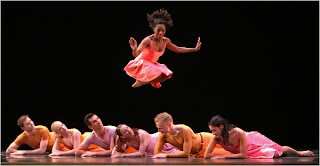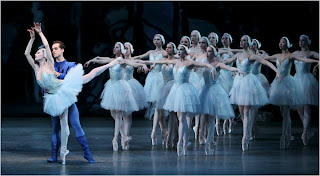
By Mary Sheeran
My music professor, James McCray (now Professor of Music at Colorado State University) defined music as a collaboration of sounds and silences. “The silences are as important as the sounds,” he would say, and as a singer I learned how true that was in controlling the dynamic of the silence.
I hadn’t thought of that definition in a spiritual sense, though; that is, in life, first you go make sounds and then you are silent, and then from your silence, you learn to make different sounds. To pattern life in this way is to make your own music of life.
I thought of this when I spent a day at the ballet, taking in both the New York City Ballet and the New York Theatre Ballet. To be specific, it was the second ballet of the day that stopped me.
The second ballet at NYCB was Christopher Wheeldon’s
After the Rain (2005), set to music by Arvo Pärt, whose career comprises periods of contemplative silences that changed and enriched his work, even transformed it. Born in Estonia on Sept. 11, 1935, Pärt’s earlier compositions were influenced by Shostakovich, Prokofiev, and Bartok, and then by serialism after Schoenberg. His work at this time came up against Soviet censors, and he consequently entered a contemplative period, studying early choral masses of European polyphony. His biographer, Paul Hillier, wrote, “He had reached a position of complete despair in which the composition of music appeared to be the most futile of gestures, and he lacked the musical faith and will power to write even a single note.”
Then, in 1971, after Pärt completed his Third Symphony, he entered yet another contemplative period, where he studied plainsong, Gregorian chant, and Renaissance polyphony. He developed a style he calls tintinnabulation, that is, little bells. The technique is inspired by chant and uses two voices, the tintinnabuli, or bell voice, which plays separate notes in a chord (ie, arpeggios) against a second voice, which moves up or down in a scale. He employs slow tempi that can be called meditative.
“Tintinnabulation,” he noted, “is an area I sometimes wander into when I am searching for answers in my life, my music, my work. In my dark hours, I have the certain feeling that everything outside this one thing has no meaning. The complex and many-faceted only confuses me, and I must search for unity. What is it, this one thing and how do I find my way to it? Traces of this perfect thing appear in many guises – and everything that is unimportant falls away. Tintinnabulation is like this…The three notes of a triad are like bells. And that is why I call it tintinnabulation.” (
arvopart.org).
Two resulting works are
Tabula Rasa and
Spiegel Im Spiegel, from the late 1970s. Wheeldon used the first movement of Tabula Rasa and all of Spiegel Im Spiegel for
After the Rain.
This ballet opens with three couples lined up on one side, the women’s legs pointing straight up, the men lying on the floor. We in the audience are simply stopped in time, moving into the music, watching the three couples, as they turn, as the men lift the women, reaching within the gentle music of a sweet high violin. The invention and the music, together are riveting, and we gasp when in one lift in midair, a woman is somehow running backwards. But all of this is merely prelude to the pas de deux between Whelan and Craig. At first, they gently rock as the violin sings beneath them. In what seems like a dance of great sweet sadness, they are always touching in some way, even when they are apart, feeling their way through some movement. Then there are gentle lifts as if trying again after a fall. On the floor, Craig holds her, she bends back, then suddenly, she is standing on his thigh and reaching out. It is yearning after the storm, with tender caring for each other, and in the end, he is sleeping beneath her, as if she were the cool, protective earth. This is a lament with hope, beautifully done, and with almost painfully beautiful music.
It is music you must hear, and Wheeldon’s dance opens the curtain to it. In an interview, discussing his “philosophy,” Part said, “If anyone wishes to understand me, they must listen to my music. If anybody wishes to know my ‘philosophy,’ they can read the Church Fathers.” But here. If you want to understand, listen for the silence and let it dance in your heart.
http://www.youtube.com/watch?v=QtFPdBUl7XQ The distillation of feeling to art is also Mozart’s gift, and NYCB eloquently sings through the delightful Mozart
Divertimento No. 15, which Balanchine called one of the finest divertimenti ever written, so of course he set it to dance (he actually did it twice). What we see are five ballerinas shimmering against the blue, and the beginning of almost delicious courtly clarity. Even though there are five women, there are three men, so that even though everything is symmetrical and balanced, it is actually a little off. You’d never notice it, given the elegance and sprightliness of the dancers, but as Balanchine showed us in Tchaikovsky Suite No. 3, there is always something simmering under cool classicism. The finale of this one, seeming so sweet and youthful, is set to an old folk song, "The Farmer’s Wife Has Lost Her Cat." Mozart made the song laugh in silver. Balanchine made it quicksilver. Here, why not listen to this one, too? (
http://www.youtube.com/watch?v=BOsIoRndPBA&feature=related). (This is the final, sixth movement. Balanchine cut the andante for violin and added a new cadenza, but you’ll hear what Mozart did to the wife and her cat. Or rather, for her.)
The last NYCB entry was Jerome Robbins’
Four Seasons, which is a little dusty but not the least bit rusty. Its formula, set to Verdi’s ballet music for the opera
I Vespri Siciliani (with additions from the ballet music for I Lombardi and Il Trovatore). The formula for
The Four Seasons is perhaps hackneyed, but it is always entertaining. Winter is greeted with the requisite shivering, followed by jaunty Springtime and sultry summer. Fall stood out in this performance, thanks to the exciting dancing of Daniel Ulbricht, Joaquin de Luz, and Tiler Peck.
Then I was off to New York Theatre Ballet. What intrigued me there was how meaning could be distilled through the movement but still convey depths of emotion. John Butler’s
Othello is certainly a good example of that. It’s startling at how well Shakespeare translates into an art form that doesn’t use language! (I always enjoyed how Balanchine would say he used the Russian translation of
A Midsummer Night’s Dream to set his version.) In this Othello, how much more we were given of Othello’s love for Desdemona, through a tender and wistful dance with the excellent Steven Melendez and Rie Ogura. Their subsequent, violent dance became all the more terrifying after Iago (Joshua Andino-Nieto) convinces Othello that Desdemona had betrayed Othello. We all knew the story, but we were caught up in it again, watching love turn into hate in but a few moments.
Antony Tudor’s
Judgment of Paris, also at NYTB, was another story that we all know from mythology, but Tudor moved the setting to a French café where the choice is not exactly among three goddesses but rather three aging “ladies of pleasure.” It’s all kind of jokey, somewhat reminiscent of “You Gotta Have a Gimmick” from
Gypsy. Tudor’s contrasting
Soiree Musicale enjoyed a sweet and engaging performance; it features different “character” dances, the canzonetta, tirolese, bolero, and tarantella, with music by Rossini arranged by Benjamin Britton. It’s always a pleasure to watch this company’s soft fluidity in ballets of this sort, and yet there’s a sense of fun behind all the grace.
The company made a big deal of explaining the importance of Merce Cunningham’s
Septet, but by the time they performed it, I felt too many words had filled the air and blotted out the dance. Otherwise, this was a charming evening, enhanced by the musical interludes provided by Mariko Miyazaki and Michael Scales on the piano.
New York City Ballet.
Divertimento No. 15, Music by Wolfgang Amadeus Mozart, Choreography by George Balanchine, Costumes by Karinska, Lighting by Mark Stanley, Premiere: May 31, 1956, American Shakespeare Theatre, Stratford, CT.
After the Rain, Music by Arvo Pärt, Choreography by Christopher Wheeldon, Costumes by Holly Hynes, Lighting by Mark Stanley, Premiere: Jan. 22, 2005, New York State Theater.
The Four Seasons, Music by Giuseppi Verdi, choreography by Jerome Robbins, Scenery and Costumes by Santo Loquasto, Lighting by Jennifer Tipton, Premiere: Jan. 18, 1979, New York State Theater.
New York Theatre Ballet.
Soiree Musicale, Choreography by Antony Tudor, Music by Giochino Rossini, Arranged by Benjamin Britten, Staging by Oona Haaranen and Ray Cook, Costumes by Sylvia Taalsohn Nolan, based on the original production by Hugh Stevenson, Lighting Design by Ted Sullivan, Pianist: Mariko Miyazaki. First performed in 1938 at London’s Palladium Theatre. Judgment of Paris, Choreography by Antony Tudor, Music by Kurt Weill, Staging by Sallie Wilson, Book and Costume Design by Hugh Laing, Costume Adaptation by Sylvia Taalsohn Nolan, Lighting Design by Ted Sullivan, Musicians: Mariko Miyazaki and Michael Scales, Premiere: Westminster Theatre, London, June 15, 1938.
Othello, Conceived and Choreographed by John Butler, Music by Antonín Dvo?ák, Staging by Donald Williams, Costume Design by Sylvia Taalsohn Nolan, Lighting Design by Ted Sullivan. Permiere: Dec. 15, 1976, at La Scala Opera Ballet in Milan, Italy. Septet, Choreography by Merce Cunningham, Music by Erik Satie, Staging by Carol Teitelbaum, Coaching by Carolyn Brown, Costume Reconstruction by Carmina de Dios after designs by Remy Charlip, Lighting Design by Ted Sullivan, Pianists: Mariko Miyazaki and Michael Scales, Premiere: Black Mountain College, North Carolina, Aug. 22, 1953.
New York City Ballet continues its Winter season through Feb. 27. For more information, go to www.nycb.org. New York Theatre Ballet will continue presentations of its Signatures 11 program April 8, 9, and May 13 and 14 at 7 p.m. at the Florence Gould Hall in New York City. For more information, visit
nytb.org.
Mary Sheeran is the author of
Quest of the Sleeping Princess, a novel set during a gala performance at the New York City Ballet (
www.questofthesleepingprincess.com) and
Who Have the Power, a historical novel set during the Comstock Lode era about a pianist discovering that her mother was a healing woman of the Washo tribe (
www.whohavethepower.com).
















